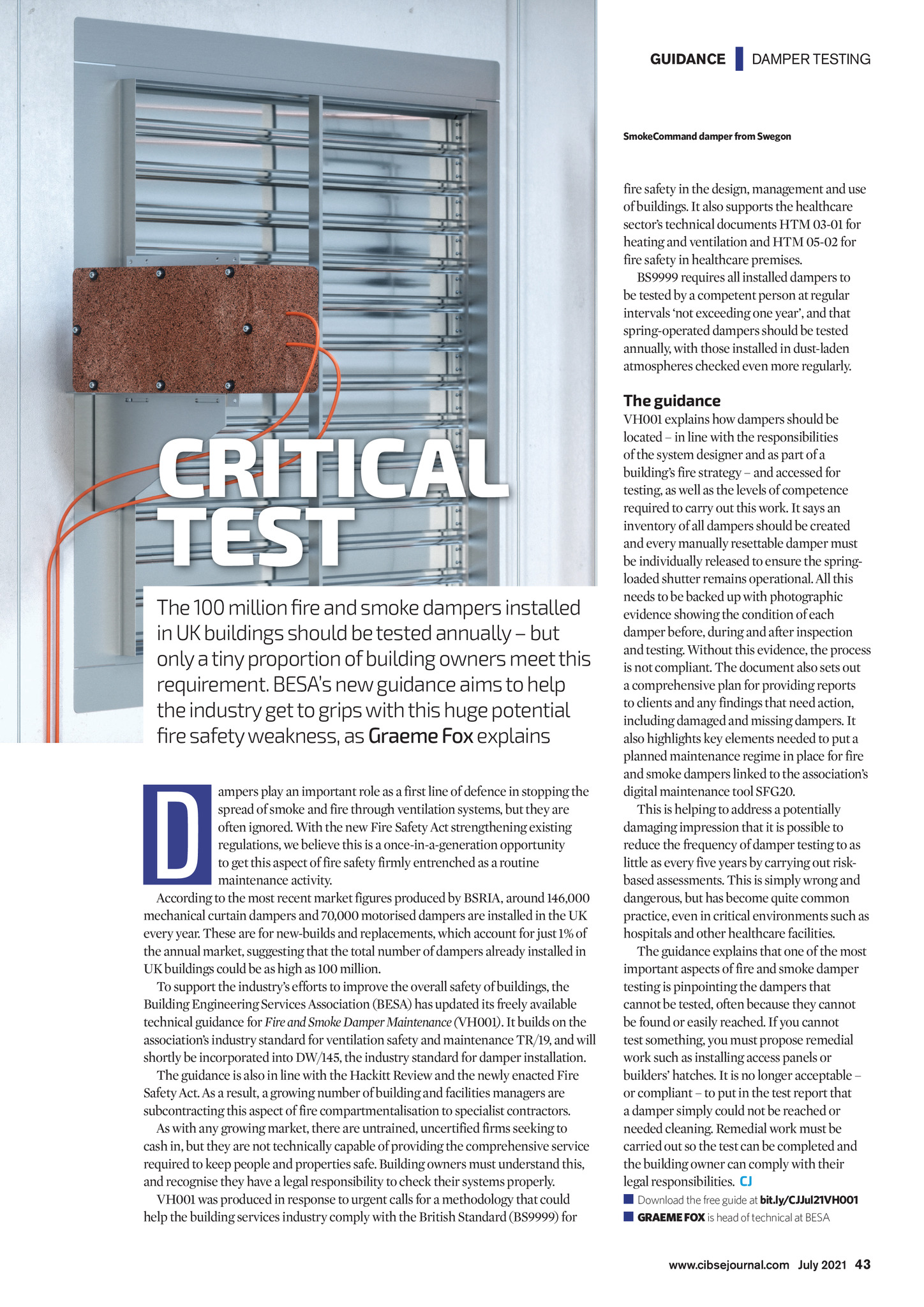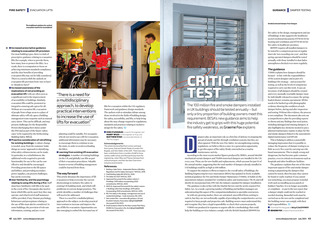


GUIDANCE | DAMPER TESTING SmokeCommand damper from Swegon fire safety in the design, management and use of buildings. It also supports the healthcare sectors technical documents HTM 03-01 for heating and ventilation and HTM 05-02 for fire safety in healthcare premises. BS9999 requires all installed dampers to be tested by a competent person at regular intervals not exceeding one year, and that spring-operated dampers should be tested annually, with those installed in dust-laden atmospheres checked even more regularly. The guidance CRITICAL TEST The 100 million fire and smoke dampers installed in UK buildings should be tested annually but only a tiny proportion of building owners meet this requirement. BESAs new guidance aims to help the industry get to grips with this huge potential fire safety weakness, as Graeme Fox explains D ampers play an important role as a first line of defence in stopping the spread of smoke and fire through ventilation systems, but they are often ignored. With the new Fire Safety Act strengthening existing regulations, we believe this is a once-in-a-generation opportunity to get this aspect of fire safety firmly entrenched as a routine maintenance activity. According to the most recent market figures produced by BSRIA, around 146,000 mechanical curtain dampers and 70,000 motorised dampers are installed in the UK every year. These are for new-builds and replacements, which account for just 1% of the annual market, suggesting that the total number of dampers already installed in UK buildings could be as high as 100 million. To support the industrys efforts to improve the overall safety of buildings, the Building Engineering Services Association (BESA) has updated its freely available technical guidance for Fire and Smoke Damper Maintenance (VH001). It builds on the associations industry standard for ventilation safety and maintenance TR/19, and will shortly be incorporated into DW/145, the industry standard for damper installation. The guidance is also in line with the Hackitt Review and the newly enacted Fire Safety Act. As a result, a growing number of building and facilities managers are subcontracting this aspect of fire compartmentalisation to specialist contractors. As with any growing market, there are untrained, uncertified firms seeking to cash in, but they are not technically capable of providing the comprehensive service required to keep people and properties safe. Building owners must understand this, and recognise they have a legal responsibility to check their systems properly. VH001 was produced in response to urgent calls for a methodology that could help the building services industry comply with the British Standard (BS9999) for VH001 explains how dampers should be located in line with the responsibilities of the system designer and as part of a buildings fire strategy and accessed for testing, as well as the levels of competence required to carry out this work. It says an inventory of all dampers should be created and every manually resettable damper must be individually released to ensure the springloaded shutter remains operational. All this needs to be backed up with photographic evidence showing the condition of each damper before, during and after inspection and testing. Without this evidence, the process is not compliant. The document also sets out a comprehensive plan for providing reports to clients and any findings that need action, including damaged and missing dampers. It also highlights key elements needed to put a planned maintenance regime in place for fire and smoke dampers linked to the associations digital maintenance tool SFG20. This is helping to address a potentially damaging impression that it is possible to reduce the frequency of damper testing to as little as every five years by carrying out riskbased assessments. This is simply wrong and dangerous, but has become quite common practice, even in critical environments such as hospitals and other healthcare facilities. The guidance explains that one of the most important aspects of fire and smoke damper testing is pinpointing the dampers that cannot be tested, often because they cannot be found or easily reached. If you cannot test something, you must propose remedial work such as installing access panels or builders hatches. It is no longer acceptable or compliant to put in the test report that a damper simply could not be reached or needed cleaning. Remedial work must be carried out so the test can be completed and the building owner can comply with their legal responsibilities. CJ Download the free guide at bit.ly/CJJul21VH001 GRAEME FOX is head of technical at BESA www.cibsejournal.com July 2021 43 CIBSE July 21 pp43 BESA dampers.indd 43 25/06/2021 16:45